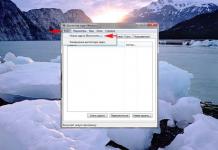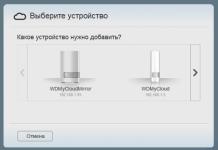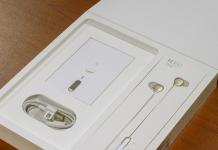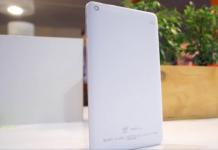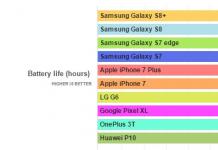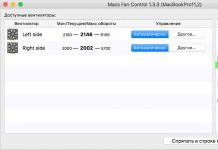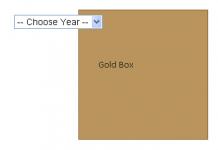The Mac OS operating system is famous for the fact that most peripheral devices can be accessed without drivers or additional settings. I just plugged the USB connector into the computer port, and everything works as it should - all the drivers are already built into the system. This also applies to printers. However, if you want to connect an old printer, or a printer from a little-known manufacturer, the system will not be able to detect it on its own. What to do in such a situation? Read our instructions :)
Connect the printer via USB cable
The easiest way to connect a printer to an Apple computer- connect it via USB port.
1. Install the driver for a specific printer model. The printer itself must be disconnected from the computer.
- Open the printer manufacturer's website in the browser and go to the support section (if the site is in English - the Support section)
- Select the series and model of your printer. You can use the search by model.

- Select the version of your operating system and download printer drivers to your computer

- Install drivers on your computer

If you do not have a regular printer, but an MFP, download the drivers for the scanner separately.
2. After installation is complete, connect the printer to the USB port of your Mac
3. Open System Preferences, and go to the “Printers and Scanners” section

4. Click the “+” button on the left side of the window

5. Select your printer from the list and click the “Add” button


Connecting a network printer via local network
Your Mac can use network printers connected to your router or Windows computers. This connection is quite simple.
1. For everything to work correctly, make sure that your Mac is in the same workgroup as the other computers.
- On the Windows computer to which the printer is connected, right-click on the “My Computer” icon and select “Properties”.
- Remember the name of the working group.

2. Open System Preferences on your Mac , and go to the “Network” section

3. Click the "Advanced" button.

4. Go to the "WINS" tab. If the value in the “Workgroup” field is different from the name in step 2, change it and click “OK”.

6. In system settings, select " Printers and scanners».

7. Click the "+" button.

8. Go to the "Windows" tab. The name of your workgroup will appear on the left side of the window. Select it.

9. Now specify the computer to which the printer is connected, click on the printer name, and click the “Select driver” button.

10. Go to the "Other" section, and select the previously installed driver.

11. Click the "Add" button.

You press the print button, but time passes and the process still hasn’t started? At the same time, the check tells you that the problem does not concern any specific document, but is systemic. There are several reasons for this, as well as their resolutions.
1. Check the Print dialog box.

If the document fails to print, press the “Command-P” function again. You will most likely see an exclamation point icon next to the printer name in the Print dialog box. This signal indicates the presence of some kind of problem and is accompanied by a message explaining what exactly the problem has arisen and how to fix it.
First, check Is the correct printer selected?: Sending a document to the wrong printer is almost the most common. It occurs if you use your laptop in different places, including the printing function. The laptop simply remembers the last of the devices, which may not be present at the moment. The fix is very simple. Select your printer from the pop-up menu in the print dialog box and try printing your document again.

Another possible reason for a printer not working could be previously suspended printing.
If printing was indeed previously paused, you will see an appropriate error message. After clicking the Resume button, try printing again. If it doesn’t work, check if there are any documents in the print queue (see below).
2. Check the print queue
If it was not possible to send a document for printing, the “Queued to print” icon will appear on the monitor, which, in fact, indicates that the document has been queued. To find out more detailed information about the reasons, click on this icon.
If the icon is not displayed, go to Apple menu > System Preferences. Then click “to scan and print”, select your printer from the list, and then click “open print queue”.
Resume paused printing. Pausing printing can occur for several reasons. The first is technical, for example due to a paper jam. The second is that you yourself paused printing by pressing pause (seeing that you were printing the wrong document or deciding that something was wrong with the printer or there was no paper) and forgot about it. This may cause the printer to not print until you resume printing. In this case, click the Resume button.

Get rid of old print jobs: they can also slow down the printer. The document that appears on the list may no longer exist. Remove it from the queue - click on the “x” next to the progress bar, below the document title.
Connection problem. If, when checking the print queue, you receive a message that there is a “message” problem with the printer or it is not connected, proceed to the next step.
3. Check the printer itself
First, check for paper availability. Look into the manual or automatic paper feed compartment for printing, depending on which one you choose to use. There may be a piece of paper stuck there.
Make sure the printer is turned on. Check whether the device is turned on to the network and whether the printer is connected via special cords to the computer or whether a wireless connection is established.

Turn the printer on and off. Preferably completely, even from the outlet. And turn it on again after a few minutes. If the error message in the print queue indicates a "communication" problem, this should help.
Check the cartridge. There may not be enough toner in it. Some models of inkjet printers refuse to print if there is insufficient ink. At the same time, if you use only black ink when printing, the device may decide that there is also no color ink and refuse to complete the task. So you may have to purchase or refill a cartridge.
Using the “Print Queue” you can check the ink supply level or try printing a test page. To do this, select “Printer” from the menu to see all the options. For diagnostics, click the “Settings” button in the “Print Queue” window. If the printer contains additional utilities (helper programs), you will find them in this section.
4. Check for printer software updates
Software updates are often carried out using OS X Software Update. To do this, select Apple menu > Software Update. If it shows that there is an update for your printer, install it. If not, you can easily find it on the company’s website. Download it and install it.
If you're having problems with your printer after upgrading to a new version of OS X, it's unlikely that the software is causing your printing problems. However, it's still worth a try, as the update process may fix the problem if the printing software has been corrupted in some way.
5. Remove and reinstall the printer

Go to Apple menu > System Preferences. Select “Print & Scan”. Select your printer from the list on the left. Click the minus sign (-) button at the bottom of the list. This will remove it from the list of printers. To add the device again, click on the plus sign (+). In theory, you should see among the
your added printers that you just deleted. If so, add it back. If not, click “Add a printer or scanner.” In theory, you will see a list of default printers. Find and choose yours. Click the add button.
Use an IP address. Network printers sometimes require additional steps. Select “Add a printer or scanner.” When the window opens, click the IP button at the top. Enter the printer's IP address. To find out how to find it, see the “Errors and Corrections” section, “Tips” column > how to find out the IP address of your printer.
Avoid sharing the printer. If you see your printer in use listed with an @ icon, such as CannonMP990 @ MacBook Pro, that means you are being offered a connection through an additional computer. Try to avoid this. And choose an alternative connection path. Otherwise, you will only be able to print when this additional device is connected, even if the attempt to re-add the printer is successful.
6. Check the error log
If you have reached this point and the error remains unresolved, look at the error log. To do this, return to the “Print Queue” item, select “Printer”> Error Log. After this, the application opens - the error_log file, which lists the possible causes of the problem. This is not the most convenient way, but sometimes it works. Thus, there were cases when the error sheet indicated that the cartridge was installed incorrectly. To correct the situation, it was only necessary to remove it and install it properly.
7. Reboot the printing system
Go to the “Print and Scan” menu. Right-click the printer name to bring up the context menu. From the list provided, select “Reset printing system.”+
After this, a message will be displayed that further steps will lead to the deletion of all existing printers, scanners, faxes and held jobs. Essentially, this action will completely clean your computer and return it to the same level as when you first unboxed your laptop. The prospect is not happy. But this may be the last solution if all the previous ones did not lead to a solution to the problem.
To ensure not only the safety of working with the printer, but also to protect your Mac, we recommend purchasing a case for macbook air 13 from itrade.
To set up a wireless connection, follow these steps:
Click Open to launch the Wireless Setting application.
Rice. : Example of launching the Wireless Setting application

The Samsung Easy Wireless Setup page is open on the main installation screen. Click Next to begin configuration.
Rice. : Example of Samsung Easy Wireless Setup main screen and Next button selection

Make sure the printer is turned on and connected to your Mac using a USB cable.
Rice. : Example of a reminder to turn on the printer and select the Next button.

Select a wireless connection setup method. To initially set up a printer that is not connected to a network, select Using a USB cable(Using a USB cable) and click Next.
Rice. : Example of choosing a wireless connection setup method

Temporarily connect the printer to your Mac (if you haven't already) and click Next.
Rice. : Example of temporarily connecting a device using a USB cable

The installation wizard will search for all connected devices and obtain information about the wireless network.
If the printer could not be detected, a dialog box will appear. Printer Not Found(Printer not found). Check the USB connection between the printer and your Mac, and then click Next in the Printer Not Found window. Try using a different USB cable if available.
If the printer still cannot be detected, the dialog box will appear again. Printer Not Found(Printer not found). Make sure the printer is turned on and ready to print, and then click Next in the Printer Not Found window.
Rice. : Device check example

Make sure your wireless router or access point broadcasts on the 2.4 GHz band and not the 5 GHz band. Samsung printers do not currently support 5GHz.
Check if another wireless device connected to the same access point has a stable signal (at least 2 bars). Please be aware that the antenna power varies from device to device. If the signal level on your laptop or phone is one bar, there will likely be no signal on the printer.
If the signal is strong and stable but the printer does not see the network, click Advanced Settings and manually enter the network information.
In the appropriate field, enter the security key (WEP/WPA/WPA2) and click Next.
Rice. : Example of setting up wireless security

Note.
If you do not know the security key, contact your network administrator or router/access point manufacturer for assistance.
The printer will try to connect to the selected wireless network.
Rice. : Example of connecting to a wireless network

Connect the USB cable to the printer's USB port and the other end to your Mac.
Once connected, start setting up your wireless network by opening the Wireless Setting app.
Note.You can download the EasyWirelessSetup_Mac application. Alternatively, go to (Download Software and Drivers) and enter your printer model in the search text box to download Easy Wireless Setup.
Rice. : Example program for setting up a wireless connection EasyWireless Setup
A list of wireless networks that are available to the printer will appear on the screen. Select a network and click Next. A dialog box will open Wireless Network Security(Wireless Network Security). If the network you need is not listed, try the following.
Rice. : Example of searching for available wireless networks

Installing a new printer and setting up a printer on Mac OS, due to the general user-friendliness of this system, usually does not present any particular difficulties.
However, there are a number of points that are worth knowing when connecting a printer to yours. Knowing these subtleties will allow you to understand how to print on a Mac OS printer.
- Connect your printer to the appropriate connector on your computer
- Turn on your printer
- If the printer came with a driver disc, insert it and install the drivers. After that, it will appear in the “printer” menu.
- To check if it is working correctly, open any text document or photo, then click “Print”.
If you are connected to a network, Mac OS will try to find printers already connected to your network and display them in the list of network printers in the Printer Browser window.
We would like to note that for the printer to work correctly and to use all its functions, after installing it, you should close all active programs and then reopen them.
System tools for setup
When carrying out a procedure such as setting up a printer on Mac OS, you can use the tools of the system itself. In particular, on the toolbar there are buttons “Standard” - intended to display a list of printers found in the system, “Fax” - add a fax queue, “IP” - used to add network printers that do not work with the Bonjour and Windows systems. - will help in installing a printer that can be shared with computers running Windows OS.
In the Mac OS print settings, there are various settings that control the operation of the printer: you can set the number of copies, text format, print paper size, etc.
You can also create your own necessary sets from the settings and apply them if necessary. To achieve the best print quality, be sure to select paper accurately.
When you start print jobs, a printer icon responsible for the print queue will appear in your system dock. There you can cancel a print job, check the ink, and perform a number of other actions.
If the printer refuses to print, cancel the job from the print queue, then turn off the printer and wait a few seconds. Turn the printer back on and try printing again.
Any MacBook or iMac has software that allows you to use a printer from almost any brand. Installing it is very simple, but often there are differences in the instructions, because not only different manufacturers, but also different models may have differences in setup methods.
Connecting equipment directly
The first step will simplify and speed up the installation of the printer: download updated drivers for your device model from the manufacturer’s website. If there is no update, most likely the firmware is enough to work. Turn on the printer and connect one end of the USB to it. The second one needs to be installed on the MacBook. In Mac, click on the “System Preferences” => “Print and Scan” button. There you can make sure whether you installed the device correctly or not. If you are not sure that the computer sees the device and you managed to connect it, open any file that can be printed, in the “File” menu, click “Print” (hot keys – “Comand-P”). Your printer should appear in the pop-up window in the corresponding menu. If it doesn't appear, try adding it manually.
Network printers

To install the device, repeat the initial step from the first description. The printer can be accessed via Ethernet or wireless network. To add a printer to a hardware network that a specific computer uses:
- Go to “Finder” => “Utilities” => “Go”, then double-click on the printer setup program. Click the “Add” button and select the desired name.
- The “System Settings” button, and then “Print and Scan”. There we click on “+” to add a new printer. Then double-click on his name.
Printing process
If you succeeded in connecting the equipment, then the time has come for the main work process. Open the file you want to print. Follow the path “File => Print => ...(Printer name is selected from the menu)”. We determine the orientation of the document and other options available in the menu at our discretion (set the paper type, for example). After setting, click on “Print”.
- If the printer sends you “light signals”, most likely there are errors in the operation. It is worth consulting with specialists and finding out the causes of the problems.
- The device does not print sent files, what should I do? There is no need to sound the alarm right away. Cancel the job and turn off the device. Half a minute after turning off completely, try turning on the printer again and resuming the task.
- When printing files onto paper of a non-standard size, be sure to indicate this before printing. It is very simple to install paper and start printing, but if you break this rule, you will damage both the printer and the object being processed.
- Setting the photo quality to high is a very useful feature. However, when printing something of minor importance, you can reduce the resolution.


